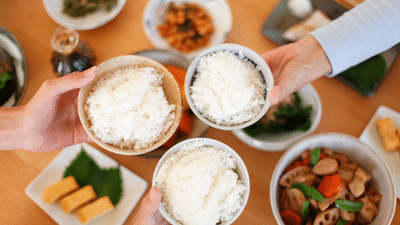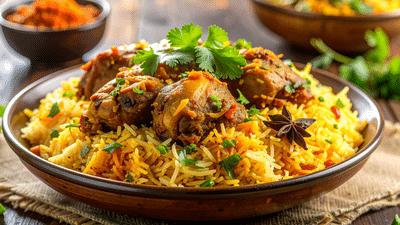In Japan, rice isn’t just a side dish. It’s the quiet centre of the meal, the calm amidst colourful plates of pickles, miso soup, and grilled fish. Every grain is respected, cooked with care, and eaten with attention. It’s simple food, yet deeply ritualistic. And while India also lives and breathes rice, somewhere between the pressure cooker whistle and the curry spill, that mindfulness has been lost. So what makes the Japanese way of eating rice so special and what can India borrow back from it? Scroll down to read more.
Rice as harmony, not heaviness

In Japan, rice isn’t meant to overwhelm a meal. It balances it. The serving size is modest - a small bowl, never piled high. It’s eaten plain, without butter, oil, or spices, so that the natural sweetness of the grain quietly complements sharper, saltier flavours like soy, seaweed, or miso. Indian plates, on the other hand, often flip the ratio - a mountain of rice with a little dal or sabzi. It fills, but doesn’t always nourish. Adopting Japan’s proportion sense, where rice plays a supporting role, not the entire show, could help bring lightness back to Indian lunches.
Respect for the grain
The Japanese treat rice like something alive. The water-to-rice ratio is precise, rinsing is done until the water runs clear, and even the way it’s fluffed post-cooking matters. Each grain should shine, never stick. Indian kitchens sometimes, often skip this quiet ritual. Rice is cooked fast, washed roughly, or left soggy under layers of curry. But what if we, too, treated it as sacred? A gentle rinse, a proper soak, and measured cooking, the same grain can taste entirely different. It’s the small acts of respect that turn an ordinary bowl into something soulful.
Tools that teach patience

Japanese households still use heavy-bottomed donabe (clay pots) or electric rice cookers at that time and control heat precisely. The process is deliberate, no rushing, no multitasking. In India, rice cooking has become mechanical - quick pressure-cooker bursts that save time but rob aroma. Clay pots, once common, now sit forgotten. A slow, steamed batch in a pot might take longer, but it teaches patience and rewards it with texture and fragrance that a cooker can’t match.
Rice with gratitude

A Japanese meal always begins with “Itadakimasu,” a phrase that loosely translates to “I humbly receive.” It’s not religious - it’s a small pause to thank the farmer, the cook, the Earth. After eating, “Gochisousama deshita”, “thank you for the meal.” India once had its own versions of this grace, prayers before meals, sitting cross-legged, eating in silence. These were ways to acknowledge food, not just consume it. The Japanese still do that instinctively. If Indian homes revived this gratitude, eating could again feel grounding - not hurried or distracted by screens.
Keeping it simple, keeping it fresh
A traditional Japanese meal, rice, soup, a protein, and a vegetable side is a masterclass in balance. Nothing too rich, nothing too sweet, nothing wasted. Flavours stay clean and fresh. In contrast, Indian meals have grown heavier, oilier, and more complicated over time. Reclaiming simplicity could mean lighter curries, steamed or stir-fried sides, and freshly cooked rice, not reheated leftovers or oversized thalis. The Japanese show that nourishment doesn’t have to be dramatic - it just has to be deliberate.
Rice as culture, not filler

Both Japan and India built civilizations around rice, yet the relationship evolved differently. Japan turned it into a symbol of purity and care; India turned it into a symbol of abundance. Both have beauty, but the Japanese approach keeps health and moderation at its core. Maybe it’s time to blend the two, India’s warmth with Japan’s precision. To slow down, serve smaller, and taste fully. To bring mindfulness back into our bowls.
Rice as harmony, not heaviness

In Japan, rice isn’t meant to overwhelm a meal. It balances it. The serving size is modest - a small bowl, never piled high. It’s eaten plain, without butter, oil, or spices, so that the natural sweetness of the grain quietly complements sharper, saltier flavours like soy, seaweed, or miso. Indian plates, on the other hand, often flip the ratio - a mountain of rice with a little dal or sabzi. It fills, but doesn’t always nourish. Adopting Japan’s proportion sense, where rice plays a supporting role, not the entire show, could help bring lightness back to Indian lunches.
Respect for the grain
The Japanese treat rice like something alive. The water-to-rice ratio is precise, rinsing is done until the water runs clear, and even the way it’s fluffed post-cooking matters. Each grain should shine, never stick. Indian kitchens sometimes, often skip this quiet ritual. Rice is cooked fast, washed roughly, or left soggy under layers of curry. But what if we, too, treated it as sacred? A gentle rinse, a proper soak, and measured cooking, the same grain can taste entirely different. It’s the small acts of respect that turn an ordinary bowl into something soulful.
Tools that teach patience
Japanese households still use heavy-bottomed donabe (clay pots) or electric rice cookers at that time and control heat precisely. The process is deliberate, no rushing, no multitasking. In India, rice cooking has become mechanical - quick pressure-cooker bursts that save time but rob aroma. Clay pots, once common, now sit forgotten. A slow, steamed batch in a pot might take longer, but it teaches patience and rewards it with texture and fragrance that a cooker can’t match.
Rice with gratitude

A Japanese meal always begins with “Itadakimasu,” a phrase that loosely translates to “I humbly receive.” It’s not religious - it’s a small pause to thank the farmer, the cook, the Earth. After eating, “Gochisousama deshita”, “thank you for the meal.” India once had its own versions of this grace, prayers before meals, sitting cross-legged, eating in silence. These were ways to acknowledge food, not just consume it. The Japanese still do that instinctively. If Indian homes revived this gratitude, eating could again feel grounding - not hurried or distracted by screens.
Keeping it simple, keeping it fresh
A traditional Japanese meal, rice, soup, a protein, and a vegetable side is a masterclass in balance. Nothing too rich, nothing too sweet, nothing wasted. Flavours stay clean and fresh. In contrast, Indian meals have grown heavier, oilier, and more complicated over time. Reclaiming simplicity could mean lighter curries, steamed or stir-fried sides, and freshly cooked rice, not reheated leftovers or oversized thalis. The Japanese show that nourishment doesn’t have to be dramatic - it just has to be deliberate.
Rice as culture, not filler
Both Japan and India built civilizations around rice, yet the relationship evolved differently. Japan turned it into a symbol of purity and care; India turned it into a symbol of abundance. Both have beauty, but the Japanese approach keeps health and moderation at its core. Maybe it’s time to blend the two, India’s warmth with Japan’s precision. To slow down, serve smaller, and taste fully. To bring mindfulness back into our bowls.
You may also like

India hands over multi-ethnic trilingual school to Lankan government

Three operatives of 'Sikhs for Justice' in Punjab Police net

Yogi Adityanath vows to crush mafia in Bihar like UP; urges voters to support NDA

"Violence came close to my house": Hardeep Singh Puri recalls horrors of 1984

National Unity Day celebrated with enthusiasm in Haryana






